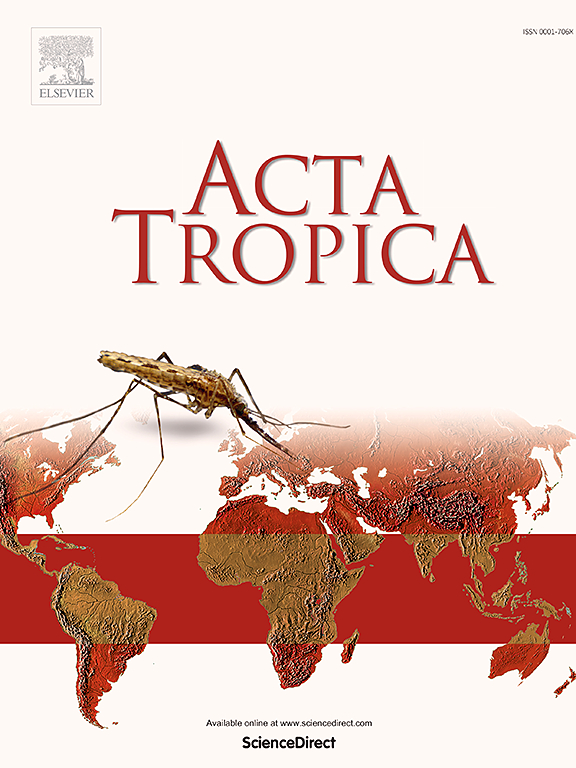Sensitivity and specificity of microscopic and molecular techniques for the diagnosis of taeniasis
IF 2.5
3区 医学
Q2 PARASITOLOGY
引用次数: 0
Abstract
Background and Objectives
The diagnostic challenges associated with T. solium continue to hamper control efforts of the world's most significant foodborne parasite and leading cause of epilepsy in low and middle-income countries. This study aimed to validate two conventional PCRs for taeniasis and estimate the diagnostic performance of microscopic and molecular tools.
Methods
Formalin and ethanol-fixed samples were tested by formalin-ethyl acetate concentration technique (FECT), Malachite smear, McMaster2 method, rrnS PCR and cox1 PCR. Initial validation of PCR methods was completed on 45 microscopy positive individuals. After validation, the performance of microscopic methods and the rrnS were estimated using samples from 1,156 individuals in Laos. Bayesian latent class models (BLCMs) and a composite reference standard were used to estimate diagnostic sensitivity and specificity.
Results
On preliminary validation the rrnS was able to detect 27/45 (60.00 %) infections whereas the cox1 detected 21/45 (46.67 %). As a result, the cox1 was excluded from further performance analysis. Microscopy methods and the rrnS were highly specific with estimates above 99.02 % regardless of analytical method. The rrnS was the most sensitive test by informed BCLM (91.45 %, CrI: 73.41–99.52 %) followed by the FECT (71.20 %, CrI: 50.53–85.48 %), McMaster2 (51.31 %, CrI: 32.00–71.29 %) and Malachite smear (32.23 %, CrI: 15.40–54.47 %).
Discussion
The inability to validate the cox1 PCR suggests that it may not be suitable in its current form for routine characterisation of Taenia spp. detected by microscopy. The rrnS presents a suitable alternative to the cox1, however, requires its products to be sequenced. Given the low prevalence of taeniasis in most populations, this should be a feasible approach that may be able to be integrated with existing soil-transmitted helminth surveys that often use FECT for microscopic diagnosis.
显微镜和分子技术诊断泰纳丝虫病的敏感性和特异性。
背景和目标:在中低收入国家,蛔虫是世界上最重要的食源性寄生虫,也是导致癫痫的主要原因,与蛔虫相关的诊断难题继续阻碍着对蛔虫的控制工作。本研究旨在验证两种传统的蛔虫PCR方法,并评估显微镜和分子工具的诊断性能:方法:通过福尔马林-醋酸乙酯浓缩技术(FECT)、孔雀石涂片、麦克马斯特2方法、rrnS PCR和cox1 PCR对福尔马林和乙醇固定样本进行检测。对 45 个显微镜检查呈阳性的个体完成了 PCR 方法的初步验证。验证后,使用老挝 1,156 人的样本对显微镜方法和 rrnS 的性能进行了估计。贝叶斯潜类模型(BLCMs)和综合参考标准被用来估算诊断灵敏度和特异性:经初步验证,rrnS 能够检测出 27/45 例(60.00%)感染,而 cox1 则检测出 21/45 例(46.67%)。因此,cox1 被排除在进一步的性能分析之外。无论采用哪种分析方法,显微镜方法和 rrnS 的特异性都很高,估计值都在 99.02% 以上。根据 BCLM(91.45%,CrI:73.41-99.52%),rrnS 是最敏感的检测方法,其次是 FECT(71.20%,CrI:50.53-85.48%)、McMaster2(51.31%,CrI:32.00-71.29%)和孔雀石涂片(32.23%,CrI:15.40-54.47%):讨论:无法对 cox1 PCR 进行验证表明,其目前的形式可能不适合用于显微镜检测疟原虫属的常规鉴定。rrnS 是 cox1 的合适替代品,但需要对其产物进行测序。鉴于大多数人群中疟原虫病的发病率较低,这应该是一种可行的方法,可以与现有的土壤传播蠕虫调查相结合,后者通常使用 FECT 进行显微诊断。
本文章由计算机程序翻译,如有差异,请以英文原文为准。
求助全文
约1分钟内获得全文
求助全文
来源期刊

Acta tropica
医学-寄生虫学
CiteScore
5.40
自引率
11.10%
发文量
383
审稿时长
37 days
期刊介绍:
Acta Tropica, is an international journal on infectious diseases that covers public health sciences and biomedical research with particular emphasis on topics relevant to human and animal health in the tropics and the subtropics.
 求助内容:
求助内容: 应助结果提醒方式:
应助结果提醒方式:


